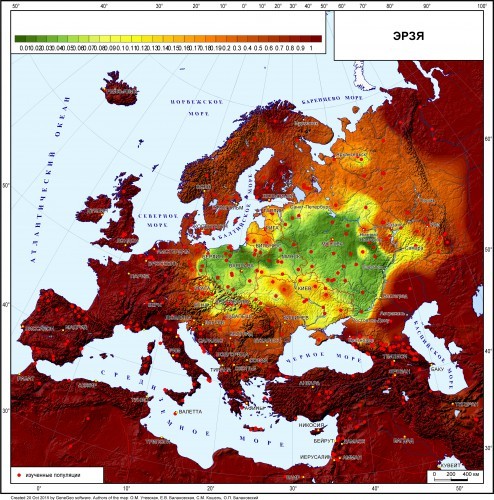2






http://eujournal.org/index.php/esj/a...File/4182/4018
THE STORY OF TWO NORTHWARD MIGRATIONS - ORIGINS OF FINNO - PERMIC AND BALTO - SLAVIC LANGUAGES IN NORTHEAST EUROPE, BASED ON HUMAN Y - CHROMOSOME HAPLOGROUPS
in short R1a M558 carried Ugro-Permiac languages, R1a M458 with I2a was already "Slavic"
Карта генетических расстояний от популяции эрзя до популяций Евразии. Зеленым цветом обозначены зоны генетического сходства (О.П.Балановский) // Map of genetic distances from the Erzya population to the populations of Eurasia. Green areas denote zones of genetic similarity (OP Balanovskiy)



maps source: http://генофонд.рф/?page_id=5629


















| Thumbs Up/Down |
| Received: 8,204/1,115 Given: 5,689/520 |














| Thumbs Up/Down |
| Received: 3,603/953 Given: 409/684 |


Inner and Central Asia is an overlap zone for the R1a1-Z280 and R1a1-Z93 lineages [which] implies that an early differentiation zone of R1a1-M198 conceivably occurred somewhere within the Eurasian Steppes or the Middle East and Caucasus region as they lie between South Asia and Central- and Eastern Europe."
Pamjav, Horolma; Fehér, Tibor; Németh, Endre; Pádár, Zsolt (2012), "Brief communication: new Y-chromosome binary markers improve phylogenetic resolution within haplogroup R1a1", American Journal of Physical Anthropology, 149 (4): 611–615, doi:10.1002/ajpa.22167, PMID 23115110













| Thumbs Up/Down |
| Received: 52,638/1,011 Given: 43,539/788 |


This is what they think on Hungarian FTDNA project
R1a-Z280: the North-EastEuropean subclade of R1a-M417, approximately 4700 years old. It is common from the Baltic to the Urals as well as the Carpathian Basin. Part of the Steppe Magyars likely belonged to this group, as the “Carpathian B type” typically appears in Russia and the Carpathian Basin. The “Carpathian D type” is typical for Slovenes and Hungarians. The Z92 subgroup is more typical for Northeast Europe (Balts, Russians and Volga Finns). The subgroups of M458 and Z280 might be linked to Bronze Age Central European Lusatian Culture (1300-500 BC) basedon their age and geographic spread.
R1a-Z93: the Asian subgroup of R1a-M417, approximately 4700 years old. It is common among Altaian Turks, Kyrghyz, Ashkenazi Jews, Indians and Eastern Iranians. Associated with the Central Asian Bronze Age Andronovo culture. In the Carpathian basin, it can be considered as Turkic admixture.
https://www.familytreedna.com/groups.../about/results













| Thumbs Up/Down |
| Received: 52,638/1,011 Given: 43,539/788 |


Because of fact that Hungarians (whatever they were called back then) took Christianity and were baptized they rescued original R1a language of Ugro-Permic folk, conquerors (Rome Christianity) impose rules, religion and language. White Croats and Serbs went south (or already were there) imposed their language to other Sarmatians (like R1a M458 people)
easy as that


















| Thumbs Up/Down |
| Received: 8,204/1,115 Given: 5,689/520 |


I2a1 is Turkic
R1a is Indo-European Balkan Native & Slavic.
Avars came to Dalmatia as I2a1, conquered it, pillaged it and now we live here.
Bosniaks, Serbs and Croats who carry I2 are Avars Turks children of Bayan.
R1a are Slavic & Native survivors who fled to Hungary and North East.
There are currently 1 users browsing this thread. (0 members and 1 guests)
Bookmarks